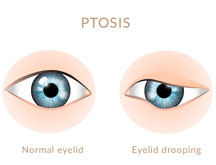
Ptosis surgery, also known as blepharoptosis surgery, is a procedure performed to correct drooping of the upper eyelid. Ptosis can occur due to a variety of reasons, including age-related changes, congenital factors, or neurological conditions. Here are key points about ptosis surgery:
Indications:
- Ptosis surgery is indicated when the upper eyelid droops low enough to interfere with vision or when there is a desire for cosmetic improvement.
Types of Ptosis:
- Congenital Ptosis: Present from birth, often due to underdevelopment of the muscles that lift the eyelid.
- Acquired Ptosis: Develops later in life and can be caused by age-related changes, muscle weakness, or neurological conditions.
Surgical Techniques:
- Levator Resection: This is a common technique where the surgeon shortens the levator muscle, which is responsible for lifting the eyelid.
- Müller Muscle Resection: In some cases, the Müller muscle, located in the upper eyelid, may be addressed to improve eyelid position.
- Frontalis Sling: In severe cases of ptosis, a sling may be created using tissue from the patient's thigh or a synthetic material to connect the eyelid to the frontalis muscle on the forehead.
Anesthesia:
- Ptosis surgery is typically performed under local anesthesia with sedation or general anesthesia, depending on the patient's preference and the complexity of the surgery.
Surgical Goals:
- The primary goal of ptosis surgery is to elevate the upper eyelid to improve vision and achieve a more symmetrical and aesthetically pleasing appearance.
- Surgeons aim to achieve a natural-looking eyelid position that complements the patient's overall facial features.
Recovery:
- Recovery time varies, but patients may experience some swelling, bruising, and discomfort in the days following surgery.
- Eye drops and ointments may be prescribed to prevent infection and promote healing.
- Patients are advised to avoid strenuous activities and follow the surgeon's instructions for postoperative care.
Results:
- The results of ptosis surgery are often long-lasting, providing improvement in both functional and cosmetic aspects.
- Full recovery and stabilization of the eyelid position may take several weeks.
Complications:
- Complications are rare but can include overcorrection, undercorrection, asymmetry, and changes in eyelid crease position.
- Close follow-up with the surgeon is important to monitor for any issues and ensure optimal outcomes.
Ptosis surgery is tailored to each individual's unique anatomy and goals. The decision to undergo ptosis surgery is based on a comprehensive evaluation by an oculoplastic or eyelid surgery specialist. If you or someone you know is considering ptosis surgery, it's important to consult with an experienced surgeon who can assess the specific factors contributing to ptosis and provide personalized recommendations for the most appropriate surgical approach.